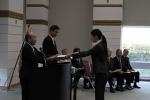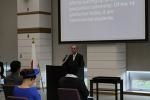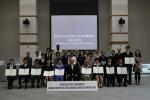2012/09/28
On Tuesday, September 25, 2012, a graduation ceremony was held in the Training Hall in the Center for Frontier Science and Technology.
President Isogai presented degrees to each graduate and gave the congratulatory speech to the 14 graduates.
After the ceremony, the commemorative photograph was taken and the graduates enjoyed the graduation ceremony with the president, executive directors and their supervising professors.
*Number of Graduates in September
【Master's Graduates】
Information Science 4
Biological Sciences 2
【Doctoral Graduates】
Information Science 5
Biological Sciences 2
【Graduates who completed the Doctoral program by submitting the dissertation】
Biological Sciences 1
【Congratulatory Remarks to Graduating Students by President ISOGAI】
On behalf of all staff and faculty at NAIST, I extend my heartfelt congratulations to all the students receiving their doctoral and master's degrees here today, the second graduation ceremony of the 2012 school year.
All of you here today have not only diligently studied in NAIST's master's and doctoral programs, but have also written outstanding academic theses in the leading fields of science and technology. As NAIST President, I would like to recognize your vast efforts leading up to this graduation ceremony. Of the 14 graduates today, 8 are international students. This high percentage of graduating international students at a ceremony is a first in the history of NAIST, and I believe this reflects the internationalization that our school has achieved to date. To the international students, who have left their native country to live and study in Japan where the customs and culture are quite different, I express my heartfelt congratulations to you.
Including the graduates in front of me today, NAIST has conferred 5560 master's and 1096 doctoral degrees since its establishment. We look forward to your future accomplishments as an important member of our distinguished alumni.
With the large number of international students graduating today, I would first like to talk a little about internationalization at NAIST.
Since the establishment of the first master's program in 1993, twenty years have passed. In that time the number of international students enrolled at NAIST increased from around thirty in the late nineties to around fifty in the early 2000's.Then from 2008, the number of international students increased rapidly, with the present number at 140, roughly 10% of the total student population, and 20% of all doctoral students. With our goals to be a recognized, top-class institution not only domestically but also on a global level, this increase in overseas students is the result of our active efforts towards internationalization. Including today's graduates, NAIST has conferred 135 master's and 113 doctoral degrees to international students, and among these alumni are graduates who have returned to their native countries to become university professors.
Now, not only in the economic world but also in the world of education, the word globalization is used quite often. Along with this, the word internationalization has been used for a long time. I believe these two words have two slightly different meanings. I feel that globalization refers to global standards. The achievement of research results that are globally recognized and the cultivation human resources that will be globally active demonstrate the globalization of research and education. On the other hand, I believe that internationalization is the understanding of various countries and regions, a localized view of the entire world. Global human resources will in fact be employed in various regions and countries around the world, where international perspective and understanding are required. In one way, if the focus of globalization is civilization and progress, then internationalization is concerned with culture. Students will learn about the existence of other various cultures in the world and consider how they will live in today's international society. This is the internationalization of education. Thinking of NAIST's internationalization and keeping with this thought, our first step is providing education to international students. After graduation, many of these students will go back to their home countries and be active as leading scientists and specialists, and simultaneously they will be the basis for ties between their countries and Japan. Others will work in international industries based in Japan.
This is the first goal.
The second goal is the internationalization of Japanese students. Those Japanese students who have studied alongside international students will develop into adults with international perspectives and understanding, working domestically and internationally as globally essential human resources. In this way, it is extremely important that students of the same generation, both Japanese and international, study and interact closely with one another.
To the international students here today, did you have enough interaction with the other students?
I hope you have created ties with students and faculty that will continue after your graduation. I also hope you will create and become part of an alumni network in your home country. Through this network, you may share your experiences and create opportunities beneficial for all alumni. I believe that this is an important part of having studied at NAIST. As President, I would like to thank all the international students for contributing to raising the international awareness of the Japanese students. The research laboratories themselves have become very internationalized. With your presence at NAIST, I feel that our students have developed a deep understanding of the international society surrounding them. I hope the relationships you have built here will continue and the Japanese students will someday want to visit your home countries. Furthermore, as an educational institute, I hope to create future opportunities for you to do further research here at NAIST.
Now I would like to talk about another topic.
What meaning does receiving your degree and graduating from NAIST have when thinking about your career?
In China there is an old saying I would like to share with you.
"There were many fish that try to swim up the Ryumon rapids in the upper waters of the Yellow River, but only the carp could swim up the rapids successfully and became dragons."
From this, being recognized by someone in power and then being able to go out into the world to actively perform is called Toryumon (登竜門). In Japan, carp streamers are put up in May as an event expressing parents' wishes for their children's future to be like that of the carp, strongly heading upstream. It can be said that you as students were carp heading up Ryumon, NAIST, and now you are dragons, having finished your studies. Now, with a promising future, maybe all you have to do is swim through the calm waters to where you can make your way in the world. Maybe it will not be so easy though.
Recently, in a newspaper article I came across the words "the half-life of knowledge" and "the expiration limit of knowledge." I talked about these in a previous "President's Message," so I will spare you the details, but the basic concept of these two phrases is as follows:"The knowledge you attain during your university studies has time limitations regarding its practical use in the world. However, what you should learn at a university, including how to search for truth and aim toward the cutting edge, and also the perseverance and strength to solve seemingly unanswerable questions, is unlimited in its practical application." At NAIST entrance ceremonies and other events I always talk about my wish that new students will learn the ethos of science at NAIST. This is very similar to what the newspaper article was stating. What you have learned during your studies here at NAIST is not only collecting information to gain knowledge, but the importance of thinking for yourself and continuing your education. With this approach, and fueled by effort and determination, you will be able to obtain your own true knowledge, for which there is no expiration limit or half-life.
All of you sitting before me today have swum up the Ryumon rapids to become dragons. However I believe that you are still young dragons. From this day, you will head out into the world as scientists and will surely encounter some difficulties. If you don't deal with these obstacles you will not be able to become a real dragon that will fly above the clouds. When you face such obstacles, what you have learned at NAIST, the power of continued thought and continued education, will surely help you. The time you have spent here at NAIST consisted of strict training to develop this strong perseverance. The diplomas we will be handing to you are proof that you have completed this rigorous training.
In the world you are heading into there are numerous problems facing us on a global scale, such as the environment, energy, and food supply. For Japan and also the rest of the world this will be an era of drastic change. Science will forge society and society will forge science. In an era in which science and society interact closely, the role and responsibility of scientists in society will become increasingly important. As you enter the workforce, I hope that you keep as your aim "to lead society with science that society can trust". Your work will show society the importance of our university and lead to the future support of NAIST. I hope all of you lead healthy, meaningful lives. Please come back to NAIST and let us know about your future endeavors.
Congratulations.
Akira Isogai
Nara Institute of Science and Technology President, September 25, 2012







